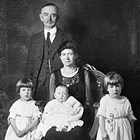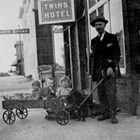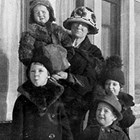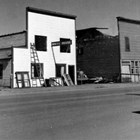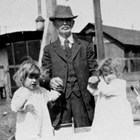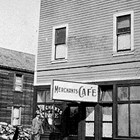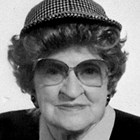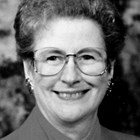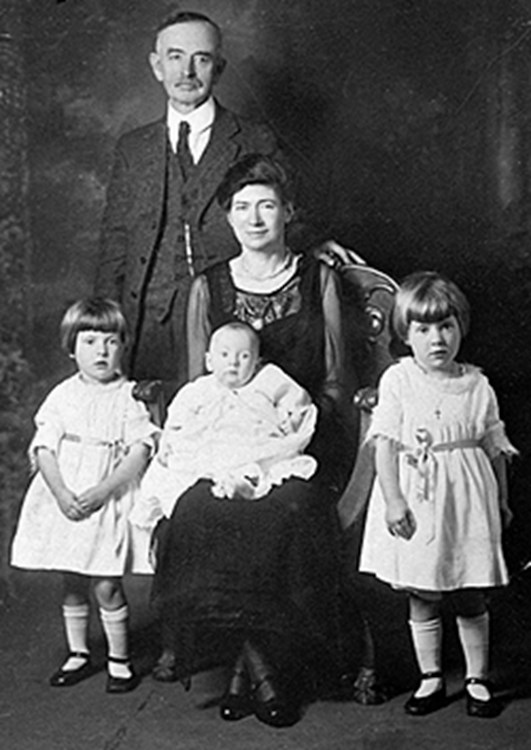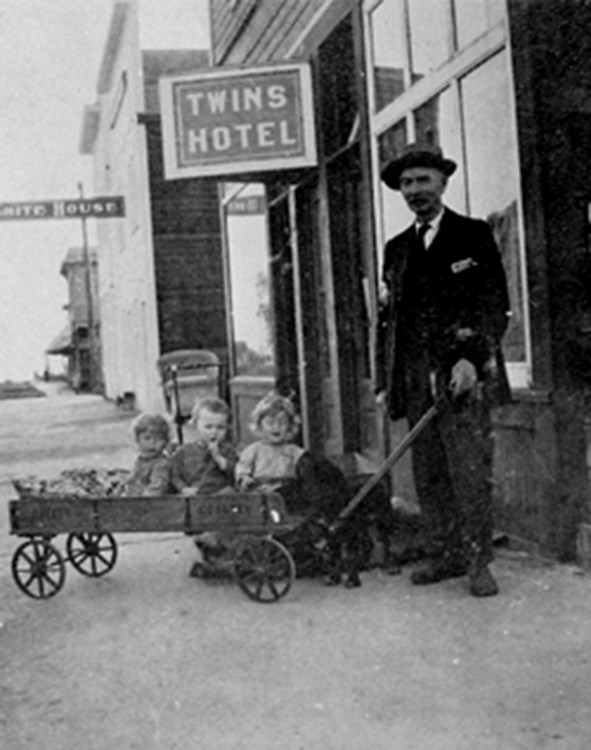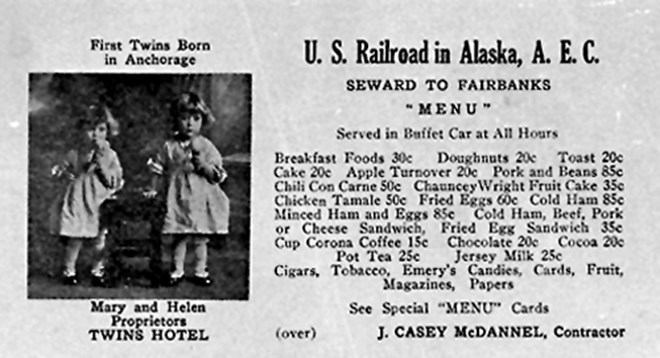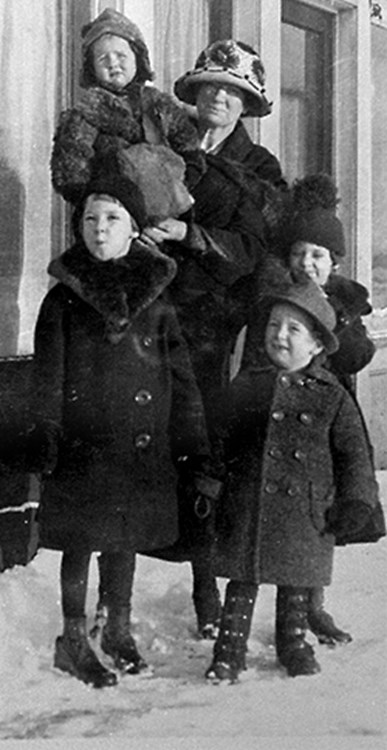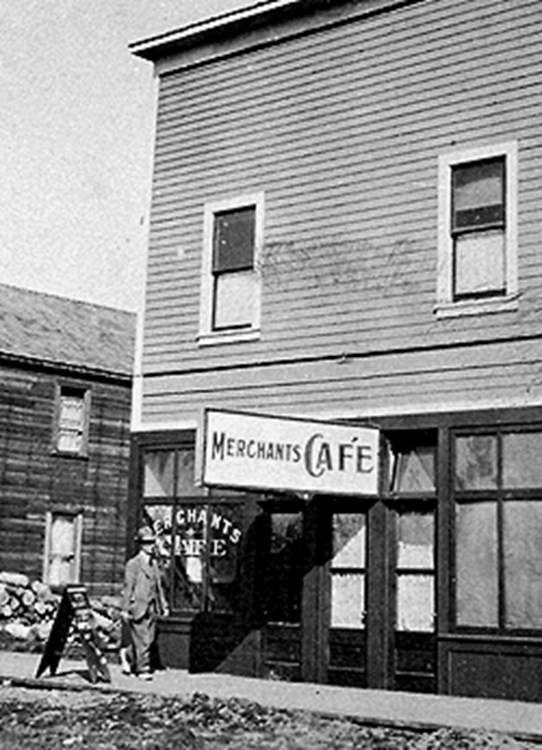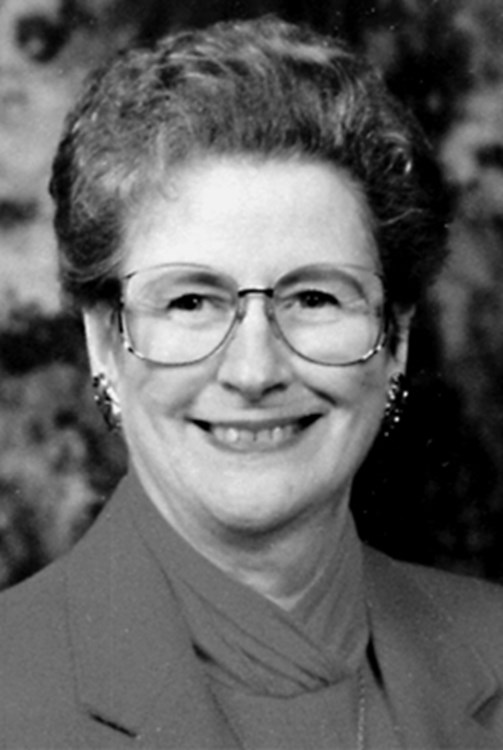McDannel, John Casey
1864-1930 | Hotel Owner and Proprietor
John Casey "Casey" McDannel was born in Knoxville, Tennessee, on June 4, 1864. As a young boy he left his home in Alabama with his two brothers, Hugh and Joseph, and drifted to different sections of the country. His two brothers traveled north, to Maryland and Washington.[1]
John Casey McDannel went west, stopping first in Kansas City, Missouri. He continued on to a mining camp in Cripple Creek, Colorado. He followed the gold trails in Nevada, and eventually in the rush to the Klondike, and in 1898 he traveled over the Chilkoot Pass and down to Dawson (Yukon Territory). In 1900 the Nome gold rush attracted him, but his luck was no better there than in Dawson. After leaving Nome, he returned to Nevada, and again engaged in mining and also hotels. He was involved in the ownership of four hotels in Nevada--at Tonopah, Columbia, Bullfrog, and Goldfield, some in partnership with George Wingfield, one of the state’s most powerful economic and political figures.[2] In Goldfield, in 1907, he built the $125,000 Hotel Casey, an elegantly furnished, three-story hotel with fifty-four rooms and suites, which was considered the largest and finest in the state of Nevada at that time. He was also a prosperous mine owner in the Gold Belt mining district (later Eden mining district) in Nye County, Nevada, where gold and silver were discovered in 1905.[3]
McDannel married Christina “Chrissie” Dubois Moore on May 20, 1903, in Carson City, Nevada. Around 1909, they left southern Nevada for a short time and opened a hotel in Coalinga, California, and then returned to Columbia, Nevada, to reopen the Merchant’s Hotel. They were later divorced.
In 1911, it was reported that McDannel also established a hotel in the mining camp of Antelope, Nevada, near Goldfield. In February 1913, the Nevada State Journal (Reno) stated that there were “noticeable signs of speed” in building another Hotel Casey at Upper Rochester, Nevada, a silver-mining town in Pershing County, Nevada, which he opened later that year. In December 1913, he returned to Reno after making an extended visit to Alaska and the Pacific Northwest states.[4]
Alaska and the north were in McDannel's blood and, in 1915, he heard of the new terminus of the Alaska Railroad being built in Anchorage. He headed north that spring, and first found a job with the Alaskan Engineering Commission (AEC) in the commissary and mess hall. When the railroad opened up in 1920, he received the concession for the railroad dining cars and sleepers from Seward to Fairbanks until the Curry Hotel stopover was built. The private car, “Seward,” was fitted out as a buffet car and assigned the route between Seward and Anchorage. It was placed into service on February 21, 1920, with Casey McDannel as chef, and was soon a hit. Many travelers reported that they had received better service on the “Seward” than on long established railroad diners in the Lower 48 states. The menu included a large variety of dishes, including oyster soup for $0.25, fried or baked halibut for $1.00, and prime rib of beef for $1.50. On July 1, 1923, his contract was ended when the Alaska Railroad started its own dining service on the railroad on July 25, 1923.[5]
During the summer of 1923, McDannel also started a short-lived tourist business with Quigley & Barash Totem Tours of Seattle, Washington. They offered a thirty-day, 5,000-mile trip by boat, automobile, and a 467-mile train ride along the Alaskan coast and into the interior, from Seward to Fairbanks. Curry Hotel was opened at Curry (Mile 249), all passengers stopped overnight and had their meals there. The Alaska Railroad put into place equipment – dining and sleeping cars, combination sleeping-observation cars, and coaches for regular and special tourist service which it operated. This move put McDannel out of business.[6]
Undaunted, McDannel opened the Twins Café in Anchorage, which name was later changed to the Merchants Café. He operated the restaurant in conjunction with the Twins Hotel at 931 4th Avenue, Anchorage.
McDannel married Mary Davis Dempsey on August 10, 1920,[7] in Anchorage, Alaska, with Judge Leopold David performing the ceremony. It was her second marriage. Mary Davis was born in Tredegar, Wales in 1878, and emigrated to Seattle. In 1913, she came to Juneau, Alaska as a tourist, but ended up staying when she was employed as a housekeeper for U.S. District Court Judge Robert W. Jennings and his wife, Ada. In 1915 she embarked for Anchorage to work as a waitress with the AEC. It was here that she met McDannel. During her first marriage, she had given birth on December 4, 1917 to twin girls, Helen and Mary, reportedly the first set of twins born in Anchorage.[8] They became part of the McDannel family. The couple had two more children, John Casey ("J. Casey"), born in 1922; and Lucy, born in 1923.[9]
In 1923, the AEC asked McDannel to operate its dining car for President Warren G. Harding’s trip to Nenana. The first president to visit Alaska, Harding went to Nenana to drive the golden spike at ceremonies on July 15, 1923 celebrating the completion of the Alaska Railroad and the Tanana River bridge.[10]
John Casey McDannel was a member of the Elks and the Moose. He was a charter member of the Pioneers of Alaska, Igloo No. 15, in Anchorage. He died on June 24, 1930 due to a lingering illness. His widow, Mary Davis Dempsey McDannel, continued to manage their family business. During the height of the depression, she lost almost all of their businesses, due to non-payment of taxes, but saved the apartment house. She died in 1955. Both are buried in the Moose Tract of the Anchorage Memorial Park Cemetery.[11]
Endnotes
[1] “Separated for Years. Two Brothers Meet Third after Quarter Century,” Washington Post, March 4, 1906, 2, https://www.newspapers.com/image/28951146 (accessed May 12, 2016).
[2] “Pioneer Boniface Visiting in Reno,” Reno Gazette-Journal (Reno, Nevada), November 8, 1909, 1, https://www.newspapers.com/image/146994092 (accessed May 12, 2016); and Oral history interview, Lucy McDannel Whitehead, March 18, 1992, Interview by Stephen Haycox and Maureen Cowles, 6, Anchorage Pioneer Oral History Project, Oral History Transcripts, 1992-1995 (HMC-0466), Archives and Special Collections, Consortium Library, University of Alaska Anchorage, Anchorage, AK.
[3] Fond Memories of Anchorage Pioneers, Vol. 1 (Anchorage: Igloo 15, Auxiliary 4, Pioneers of Alaska, 1996), 148-149; John P. Bagoy, Legends & Legacies, Anchorage, 1910-1935 (Anchorage: Publications Consultants, 2001), 63-64; undated newspaper clipping, “Goldfield’s New Buildings—Hotel Casey,” Casey McDannel file, Bagoy Pioneer Family Files (2004.11), Box 5, Atwood Resource Center, Anchorage Museum at Rasmuson Center, Anchorage, AK; and Joseph V. Tingley, Mining Districts of Nevada, Second Edition, Nevada Bureau of Mines and Geology Report 47 (Reno: Mackay School of Mines, 1998), 82, http://dwgateway.library.unr.edu/keck/mining/dox/r47/r47.pdf (accessed July 3, 2016).
[4] “State Brevities,” Nevada State Journal (Reno, Nevada), May 22, 1903, 5, https://www.newspapers.com/Image/19454847(accessed May 5, 2016); Carson City Marriage Inquiry, Entries for John McDannel and Christina Dubois Moore, Marriage Records, Carson City, Nevada, Clerk-Recorder’s Office, Book 2, Page 36, Document Number 1167, May 20, 1903, http://www.ccapps.org/cgi-bin/dmw200 (accessed May 15, 2016); “Pioneer Boniface Visiting in Reno,” Reno Gazette-Journal (Reno, Nevada), November 8, 1909, 1; “Antelope Handicapped by Difficulty in Shipping Ore,” Nevada State Journal (Reno, Nevada), December 24, 1911, 5, https://www.newspapers.com/image/78753080 (accessed May 5, 2016); “Will Again Name It the Casey Hotel,” Nevada State Journal (Reno, Nevada), February 13, 1913, 5, https://www.newspapers.com/image/75280682 (accessed May 12, 2016); and [Notice, J. Casey McDannell], Reno Gazette-Journal (Reno, Nevada), December 23, 1913, 4, https://www.newspapers.com/image/147672486 (accessed May 12, 2016).
[5] Mary J. Barry, Seward, Alaska: A History of the Gateway City, Vol. II: The Railroad Construction Years, 1914-1923 (Anchorage: Mary J. Barry, 1993), 25 and 30; and “Dining Car Service,” Alaska Railroad Record, v. 4, no. 28, May 18, 1920, 219..
[6] Oral history interview, Lucy McDannel Whitehead, March 18, 1992, Interview by Stephen Haycox and Maureen Cowles, 5, Anchorage Pioneer Oral History Project, Oral History Transcripts, 1992-1995 (HMC-0466), Archives and Special Collections, Consortium Library, University of Alaska Anchorage, Anchorage, AK; and Casey McDannel to Governor Scott Bone, n.d., File: 62-4 (Alaska Railroad), 1923, National Archives Microfilm Publication M939, General Correspondence of Alaskan Territorial Governors, 1909-1958, Roll 108.
[7] Lucy Whitehead, “McDannel-Whitehead Families,” Fond Memories of Anchorage Pioneers, Vol 1, 148.
[8] There is a photograph of the twin girls, Helen and Mary, with J. Casey McDannel, taken on February 6, 1919, in Bernadine Prince, The Alaska Railroad, in Pictures, 1914-1964, Volume 1 (Anchorage: K. Wray’s Print Shop, 1964), 358.
[9] Fond Memories of Anchorage Pioneers, Vol. 1, 148-149; and John P. Bagoy, Legends & Legacies, Anchorage, 1910- 1935, 63-64.
[10] Mary J. Barry, in Seward, Alaska: A History of the Gateway City, Vol. II: The Railroad Construction Years, 1914-1923, 31-36, gives a detailed summary of President Harding’s trip to Alaska. The schedule and guide for Harding’s 1923 Alaska trip was printed in the Bulletin of Information for the Presidential Special, July 13-19, 1923 (N.p.: U.S., Department of the Interior, 1923). A copy of this bulletin is available in the Whitehead-McDannel Collection, ca. 1908-1987 (B2012.018), folder 1, Atwood Resource Center, Anchorage Museum at Rasmuson Center, Anchorage, AK.
[11] “J. Casey M’Dannel at End of Trail, Victim of Cancer,” Fairbanks Daily News-Miner, June 27, 1930, 8, https://www.newspapers.com/image/31318105 (accessed May 12, 2016); and John McDannel, U.S., Find A Grave Index, 1600s-Current [database on-line], http://ancestry.com (accessed May 5, 2016); and Oral history interview, Lucy McDannel Whitehead, March 18, 1992, Interview by Stephen Haycox and Maureen Cowles, 8, Anchorage Pioneer Oral History Project, Oral History Transcripts, 1992-1995 (HMC-0466), Archives and Special Collections, Consortium Library, University of Alaska Anchorage, Anchorage, AK.
Sources
This biographical sketch of John Casey McDannel is based on an essay originally appeared in John Bagoy’s Legends & Legacies, Anchorage, 1910-1935 (Anchorage, AK: Publications Consultants, 2001), 63-64. See also the John Casey McDannel file, Bagoy Family Pioneer Files (2004.11), Box 5, Atwood Resource Center, Anchorage, AK. Photographs courtesy of the McDannel family. Edited by Mina Jacobs in 2012. Edited, revised and substantially expanded by Bruce Parham, July 15, 2016.
Preferred citation: Bruce Parham, “McDannel, John Casey,” Cook Inlet Historical Society, Legends & Legacies, Anchorage, 1910-1940, http://www.alaskahistory.org.
Major support for Legends & Legacies, Anchorage, 1910-1940, provided by: Anchorage Museum at Rasmuson Center, Atwood Foundation, Cook Inlet Historical Society, and the Rasmuson Foundation. This educational resource is provided by the Cook Inlet Historical Society, a 501 (c) (3) tax-exempt association. Contact us at the Cook Inlet Historical Society, by mail at Cook Inlet Historical Society, Anchorage Museum at Rasmuson Center, 625 C Street, Anchorage, AK 99501 or through the Cook Inlet Historical Society website, www.cookinlethistory.org.
